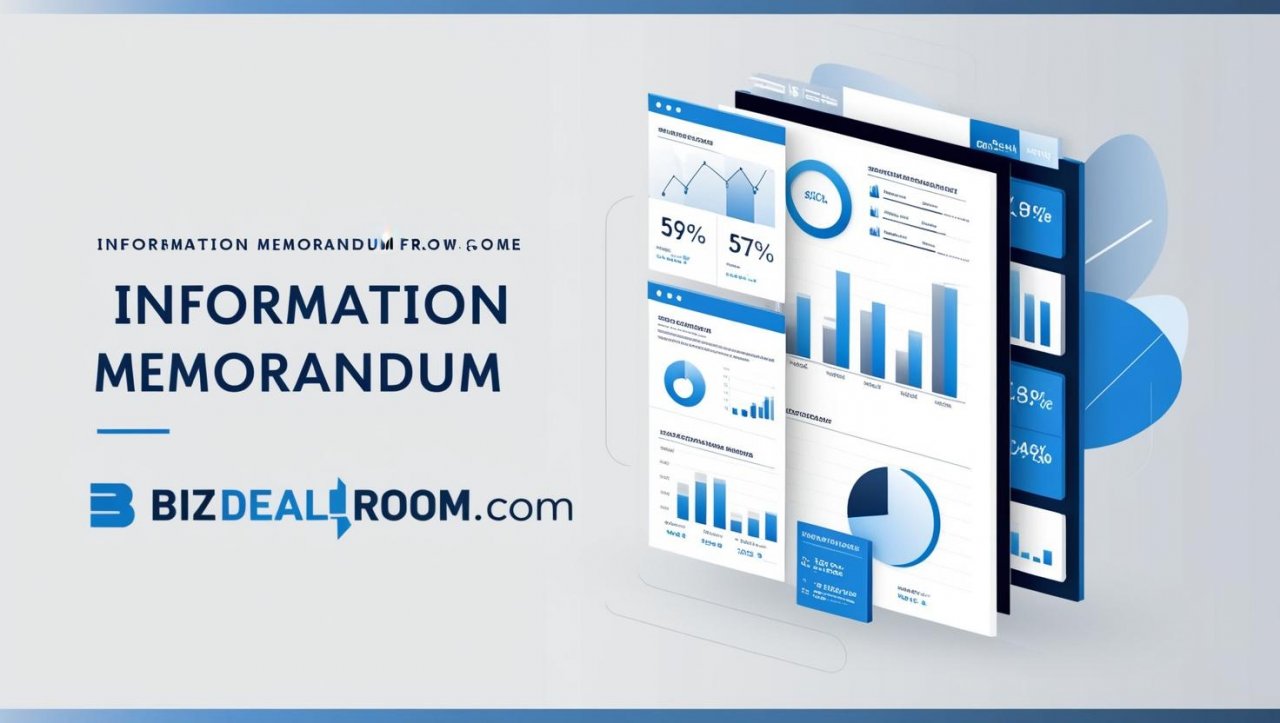Crafting a Winning Information Memorandum

Crafting a Winning Information Memorandum: The Essential Components
When seeking investment or preparing your business for sale, few documents are as crucial as your Information Memorandum (IM). This cornerstone document represents your business's first impression to potential investors or buyers, and its quality can significantly influence their decision to proceed further.
At BizDealRoom, we've analysed hundreds of successful transactions, and we've identified the key components that make an Information Memorandum truly effective. Let's explore these essential elements that can dramatically improve your chances of securing investment or completing a successful sale.
The Founder's Letter: Setting the Tone
Your Information Memorandum should begin with a personal letter from the founder or CEO. This isn't merely a formality—it's an opportunity to establish rapport and credibility from the outset.
A compelling founder's letter should:
- Convey your passion for the business and its mission
- Briefly explain your journey and what motivated you to build the company
- Address why you're seeking investment or selling now
- Express your vision for the company's future
- Demonstrate your commitment to finding the right partner, not just any investor
The founder's letter should be authentic, concise, and professionally written. It humanises your business proposition and creates an immediate connection with readers. Remember, investment decisions are rarely made on financial considerations alone—they're also based on trust in the leadership team.
The Executive Summary: Your Most Critical Pages
Research shows that many investors or buyers decide whether to read further based solely on the executive summary. This section must distil your entire business proposition into a compelling 2-3 page overview.
An effective executive summary should include:
- A clear, jargon-free description of your business and what makes it unique
- The market opportunity and problem you're solving
- Your solution and competitive advantages
- Evidence of traction and key accomplishments
- Growth strategy and future projections
- Investment opportunity or transaction structure
- Use of funds and expected returns
The executive summary should read like a standalone document that provides a comprehensive snapshot of your business. It must be meticulously crafted, as it often receives the most scrutiny. We recommend writing this section last, after completing the rest of your Information Memorandum, to ensure it accurately captures all key points.
Company History: Demonstrating Resilience and Progress
Your company's history tells the story of your journey—the challenges overcome, milestones achieved, and lessons learned. This narrative helps investors understand how your business has evolved and demonstrates your resilience.
A compelling company history section should:
- Outline the founding story and initial vision
- Highlight key inflection points and pivots
- Document significant achievements and growth metrics over time
- Acknowledge challenges and explain how they were addressed
- Show the evolution of your product or service offerings
- Illustrate increasing market penetration or customer adoption
When discussing your history, be honest about setbacks but frame them as valuable learning experiences that strengthened your business. This transparency builds credibility and shows maturity in your leadership approach.
Team and Founder Profiles: Your Most Valuable Asset
Investors often say they invest in people first and ideas second. Your team section should showcase the collective expertise, experience, and complementary skills that position your company for success.
Effective team profiles should include:
- Brief professional biographies highlighting relevant experience
- Educational background and notable accomplishments
- Specific roles and responsibilities within the company
- Prior entrepreneurial or industry successes
- Key advisors, board members, or mentors supporting the business
- Skills matrix showing how the team covers all critical business functions
When presenting the founding team, emphasise not just individual credentials but how the team works together. Investors are looking for balanced teams with the right mix of technical, operational, and commercial expertise.
The Offer: Crystal Clear Value Proposition
This section must outline precisely what you're offering investors and what they can expect in return. Ambiguity here can quickly derail investor interest.
A well-structured offer section should detail:
- The total amount being raised or the business valuation
- The investment structure (equity, debt, convertible note, etc.)
- Minimum investment requirements
- Use of funds with specific allocations
- Timeline for deploying capital
- Expected returns and exit strategy
- Previous funding rounds and existing investors
- Dilution considerations for future funding rounds
Be specific about how new capital will accelerate growth and create value. Vague statements about "marketing" or "product development" are insufficient—break down exactly how funds will be allocated and what milestones they will help achieve.
What's In It for Investors: Beyond Financial Returns
While financial returns are obviously important, sophisticated investors are often looking for additional benefits. This section should highlight all potential advantages of investing in your business.
Consider including:
- Projected financial returns with realistic timelines
- Strategic value for particular types of investors
- Potential synergies with existing portfolio companies
- Tax benefits or incentives that may apply
- Social or environmental impact metrics
- Industry influence or market positioning benefits
- Potential roles or involvement investors might have
Tailor this section to different investor profiles when possible. Strategic investors, financial investors, and impact investors all have different priorities that you should address.
Disclaimers and Warning Statements: Essential Protection
While often overlooked by entrepreneurs eager to present their opportunity, proper disclaimers and warning statements are non-negotiable components of a professional Information Memorandum.
Your disclaimers section should:
- Clearly state that the document doesn't constitute a formal offer of securities
- Acknowledge that projections are estimates only and not guaranteed
- Emphasise that investors should conduct their own due diligence
- Outline confidentiality requirements and restrictions on sharing the document
- Disclose any conflicts of interest or related party transactions
- Include jurisdiction-specific legal notices
- Clarify the status of any regulatory approvals or licences
In Australia, specific language requirements may apply depending on your offering structure. We strongly recommend having your disclaimers reviewed by a legal professional familiar with corporations law and ASIC requirements before distributing your Information Memorandum.
Bringing It All Together: Professional Presentation
Beyond the content, the overall presentation of your Information Memorandum speaks volumes about your professionalism. Ensure your document features:
- Consistent formatting and professional design
- Error-free content with proper grammar and spelling
- High-quality graphics, charts, and images
- Logical flow and clear section navigation
- Appropriate length (typically 15-30 pages plus appendices)
- Professional binding for physical copies
Consider having your Information Memorandum designed by a professional who specialises in financial documents. The investment in professional presentation typically pays for itself many times over in credibility gained.
Affordable Professional Support
Creating a professional Information Memorandum doesn't have to break the bank. At BizDealRoom, we offer cost-effective solutions that deliver exceptional value:
- Starter Information Memorandum: From just $990, we can create a great starting point that covers all essential elements
- Complete Package: For $5,950, our comprehensive service includes a detailed Information Memorandum, marketing materials, professional videos, and expert advice
Our pricing represents exceptional value in the market. Traditional business advisors and investment banks typically charge between $10,000 and $80,000 for similar services, while the top-tier firms can demand hundreds of thousands of dollars for Information Memorandum preparation.
By making professional document preparation accessible to businesses of all sizes, we're democratising access to capital and helping more Australian entrepreneurs successfully fund their growth or achieve optimal exits.
Final Thoughts
A well-crafted Information Memorandum dramatically increases your chances of raising capital successfully or achieving an optimal business sale. It serves not just as an informational document but as a powerful marketing tool that showcases your business in its best light.
At BizDealRoom, we've helped hundreds of Australian businesses prepare compelling Information Memoranda that have successfully attracted investment or facilitated business sales. Our data consistently shows that businesses with professionally prepared documents secure funding more quickly and on better terms than those that cut corners on this critical component.
Remember, your Information Memorandum is often your first and only chance to make a positive impression on potential investors or buyers. Invest the time and resources necessary to ensure it effectively communicates your value proposition and sets your business apart from the competition.
Need expert guidance on preparing your Information Memorandum? Contact our team at BizDealRoom to learn how our network of professional advisors can help you create a document that maximises your chances of success—at a fraction of traditional costs.




































